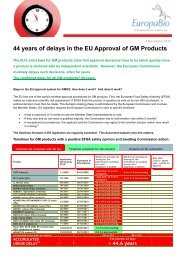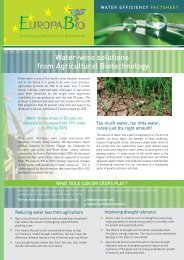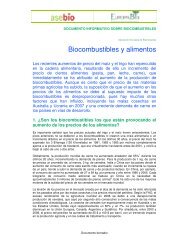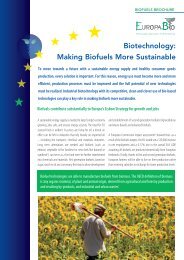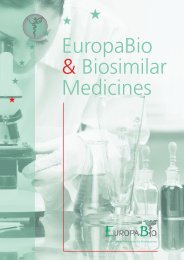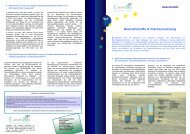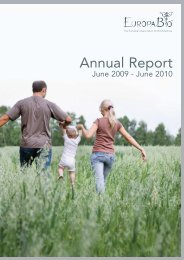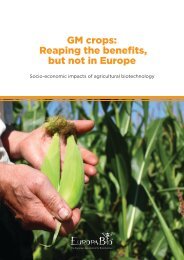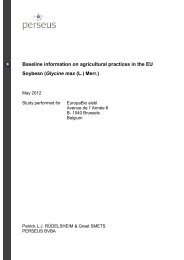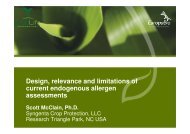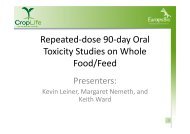Guide to Biological Medicines: A Focus on Biosimilar ... - Europabio
Guide to Biological Medicines: A Focus on Biosimilar ... - Europabio
Guide to Biological Medicines: A Focus on Biosimilar ... - Europabio
Create successful ePaper yourself
Turn your PDF publications into a flip-book with our unique Google optimized e-Paper software.
EuropaBio is the voice of the European biotech Industry.<br />
It represents the interests of the industry <str<strong>on</strong>g>to</str<strong>on</strong>g>wards the European<br />
instituti<strong>on</strong>s so that legislati<strong>on</strong> encourages and enables biotechnology<br />
companies in Europe <str<strong>on</strong>g>to</str<strong>on</strong>g> innovate and provide for our society’s<br />
unmet needs.<br />
The European Associati<strong>on</strong> for BioIndustries was created in 1996<br />
and represents 62 corporate and 7 associate members operating<br />
worldwide, 2 Bioregi<strong>on</strong>s and 19 nati<strong>on</strong>al biotechnology associati<strong>on</strong>s<br />
representing some 1800 small and medium sized enterprises.<br />
Our corporate members are involved in a wide range of activities:<br />
human and animal healthcare, diagnostics, bio-informatics, chemicals,<br />
biofuels, crop producti<strong>on</strong>, agriculture, food and envir<strong>on</strong>mental<br />
products and services.<br />
Avenue de l’Armée, 6<br />
B-1040 Brussels<br />
Tel: +32 2 735 03 13<br />
www.europabio.org<br />
Printed <strong>on</strong> recycled paper<br />
TM<br />
EuropaBio also welcomes associate members such as internati<strong>on</strong>al<br />
commercial, financial asset management and other service providing<br />
companies, regi<strong>on</strong>al biotechnology development organisati<strong>on</strong>s<br />
and scientific institutes. The comm<strong>on</strong> denomina<str<strong>on</strong>g>to</str<strong>on</strong>g>r am<strong>on</strong>g all our<br />
members is the use of biotechnology at any stage of research,<br />
development or manufacturing.<br />
<str<strong>on</strong>g>Biological</str<strong>on</strong>g><br />
<str<strong>on</strong>g>Medicines</str<strong>on</strong>g><br />
A <str<strong>on</strong>g>Focus</str<strong>on</strong>g> <strong>on</strong><br />
<strong>Biosimilar</strong><br />
<str<strong>on</strong>g>Medicines</str<strong>on</strong>g><br />
TM
EXECUTIVE SUMMARY<br />
Biotechnology has enabled<br />
the discovery of treatments<br />
for a variety of serious diseases.<br />
Worldwide, over 350 milli<strong>on</strong> patients have benefited from approved<br />
medicines manufactured through biotechnology. Currently, over 650<br />
new biological medicines and vaccines are be developed <str<strong>on</strong>g>to</str<strong>on</strong>g> treat<br />
more than 100 diseases. As the exclusive rights for these biological<br />
medicines expire, similar biological medicines, or “biosimilars”, are<br />
being developed, with some already available <strong>on</strong> European markets.<br />
<str<strong>on</strong>g>Biological</str<strong>on</strong>g> medicines are<br />
comprised of proteins and<br />
other substances that are<br />
often naturally produced in<br />
the human body. In healthcare,<br />
biotechnology is being used in<br />
three primary areas: therapeutic<br />
medicines, vaccines and<br />
diagnostics. When compared <str<strong>on</strong>g>to</str<strong>on</strong>g><br />
chemical medicines, biological<br />
medicines are generally more<br />
complex and usually much larger<br />
in size than chemical medicines.<br />
The complexity is predominantly<br />
due <str<strong>on</strong>g>to</str<strong>on</strong>g> the manufacturing<br />
process for biological medicine,<br />
as they are developed in living<br />
system the exact characteristics<br />
and properties are highly<br />
dependent <strong>on</strong> the manufacturing<br />
process. Chemical medicines<br />
can be approved either by<br />
nati<strong>on</strong>al medicines authorities or<br />
by the ‘centralised procedure’<br />
carried out by the European<br />
<str<strong>on</strong>g>Medicines</str<strong>on</strong>g> Agency (EMA),<br />
however all biological medicines<br />
products must follow the<br />
‘centralised procedure’<br />
for approval.<br />
Due <str<strong>on</strong>g>to</str<strong>on</strong>g> the compositi<strong>on</strong> and<br />
large molecule size of biological<br />
medicines, they have the inherent<br />
potential <str<strong>on</strong>g>to</str<strong>on</strong>g> induce (unwanted)<br />
immune reacti<strong>on</strong>s. Therefore,<br />
in order <str<strong>on</strong>g>to</str<strong>on</strong>g> identify unwanted<br />
immune reacti<strong>on</strong>s, and for<br />
post regula<str<strong>on</strong>g>to</str<strong>on</strong>g>ry approval<br />
commitments, treating<br />
physicians should state the<br />
brand name and batch<br />
number, as opposed <str<strong>on</strong>g>to</str<strong>on</strong>g> the<br />
Internati<strong>on</strong>al N<strong>on</strong>-Proprietary<br />
Name (INN) when prescribing.<br />
Furthermore, due <str<strong>on</strong>g>to</str<strong>on</strong>g> the unique<br />
nature of biosimilars, there<br />
should not be au<str<strong>on</strong>g>to</str<strong>on</strong>g>matic<br />
substituti<strong>on</strong> of the reference<br />
product, this decisi<strong>on</strong> should<br />
be left with the treating<br />
physician.<br />
Generics and <strong>Biosimilar</strong>s have<br />
an important role <str<strong>on</strong>g>to</str<strong>on</strong>g> play in<br />
fostering competiti<strong>on</strong> in the<br />
market place, and thereby<br />
c<strong>on</strong>tributing <str<strong>on</strong>g>to</str<strong>on</strong>g> the sustainability<br />
of healthcare budgets. However,<br />
as the research and development<br />
costs of biosimilars are much<br />
higher than generics, suitable<br />
pricing and reimbursement<br />
envir<strong>on</strong>ments are needed <str<strong>on</strong>g>to</str<strong>on</strong>g><br />
foster the development of<br />
new products. Furthermore,<br />
adequate intellectual property<br />
protecti<strong>on</strong> is vital <str<strong>on</strong>g>to</str<strong>on</strong>g> ensure<br />
that companies are able <str<strong>on</strong>g>to</str<strong>on</strong>g> fund<br />
research and development<br />
of biological medicines, and<br />
therefore develop and produce<br />
more potential treatments.<br />
Up<strong>on</strong> expiry of such protecti<strong>on</strong>,<br />
biosimilar products (unlike<br />
chemical generics these are<br />
not exact copies, as they are<br />
made in living systems the exact<br />
characteristics are dependent<br />
up<strong>on</strong> the manufacturing process)<br />
can enter the market <str<strong>on</strong>g>to</str<strong>on</strong>g> compete<br />
with the original “reference<br />
product”.<br />
So far the European Uni<strong>on</strong> has<br />
approved 7 biosimilars, across<br />
3 product classes. In the United<br />
States, the Biologics Price<br />
Competiti<strong>on</strong> and Innovati<strong>on</strong><br />
Act, signed in<str<strong>on</strong>g>to</str<strong>on</strong>g> law in March<br />
2010, created a statu<str<strong>on</strong>g>to</str<strong>on</strong>g>ry<br />
framework for the approval<br />
of biosimilars by the Food and<br />
Drug Administrati<strong>on</strong> (FDA).<br />
Over the last two years, the<br />
biosimilar market shares have<br />
steadily increased in most<br />
countries. In several European<br />
countries, biosimilars now have<br />
a higher volume market share<br />
than the reference product,<br />
and this trend appears <str<strong>on</strong>g>to</str<strong>on</strong>g> be<br />
accelerating.<br />
<str<strong>on</strong>g>Biological</str<strong>on</strong>g><br />
<str<strong>on</strong>g>Medicines</str<strong>on</strong>g><br />
A <str<strong>on</strong>g>Focus</str<strong>on</strong>g> <strong>on</strong><br />
<strong>Biosimilar</strong><br />
<str<strong>on</strong>g>Medicines</str<strong>on</strong>g>
01<br />
<str<strong>on</strong>g>Biological</str<strong>on</strong>g> <str<strong>on</strong>g>Medicines</str<strong>on</strong>g><br />
A <str<strong>on</strong>g>Focus</str<strong>on</strong>g> <strong>on</strong> <strong>Biosimilar</strong> <str<strong>on</strong>g>Medicines</str<strong>on</strong>g><br />
TABLE OF CONTENTS INTRODUCTION<br />
02 INTRODUCTION<br />
03 HEALTHCARE BIOTECHNOLOGY: INTRODUCTION TO THE SCIENCE<br />
03 What are biological medicines and how do they work?<br />
03 How do biological medicines differ from chemical medicines?<br />
Key differentiating fac<str<strong>on</strong>g>to</str<strong>on</strong>g>rs.<br />
03 How are biological medicines manufactured?<br />
05 Intellectual property for biotech medicines<br />
06 BIOLOGICAL MEDICINES – CURRENT ISSUES<br />
06 Naming, Pharmacovigilance and Risk Management Plans<br />
07 Interchangeability<br />
07 Substituti<strong>on</strong><br />
08 Impact <strong>on</strong> healthcare budget and pricing<br />
08 The regulati<strong>on</strong> of biologicals in Europe, including biosimilars<br />
09 THE MARKET FOR BIOSIMILARS<br />
09 Which biosimilars are currently available in Europe?<br />
09 What about the rest of the world?<br />
09 What does the entry of biosimilars in the market mean <str<strong>on</strong>g>to</str<strong>on</strong>g> origina<str<strong>on</strong>g>to</str<strong>on</strong>g>r products?<br />
10 THE POTENTIAL IMPACT OF BIOSIMILARS<br />
10 For patients<br />
10 For healthcare professi<strong>on</strong>als<br />
10 For payers<br />
11 GLOSSARY OF KEY TERMS<br />
12 REFERENCES<br />
Biotechnology has enabled the discovery<br />
of treatments for a variety of serious<br />
diseases. Worldwide, more than 350<br />
milli<strong>on</strong> patients have already benefited<br />
from approved medicines manufactured<br />
through biotechnology.<br />
These medicines help treat or prevent many rare<br />
and severe diseases including cancers, heart attacks,<br />
stroke, multiple sclerosis, diabetes, rheuma<str<strong>on</strong>g>to</str<strong>on</strong>g>id<br />
arthritis and au<str<strong>on</strong>g>to</str<strong>on</strong>g>immune diseases. In additi<strong>on</strong>,<br />
over 650 new biological medicines and vaccines<br />
are currently being developed <str<strong>on</strong>g>to</str<strong>on</strong>g> treat more<br />
than 100 diseases 1 .<br />
As the exclusive rights (patents and other data<br />
protecti<strong>on</strong>) for certain biological medicines expire,<br />
similar biological medicines, or "biosimilars", are<br />
being developed. Several biosimilars are already<br />
available <strong>on</strong> European markets. This document<br />
is intended <str<strong>on</strong>g>to</str<strong>on</strong>g> explain the complexities and<br />
specificities of biological medicines, including<br />
biosimilar medicines.<br />
“<br />
<str<strong>on</strong>g>Biological</str<strong>on</strong>g> medicines are<br />
comprised of proteins and<br />
other substances that are<br />
often naturally produced<br />
in the human body.<br />
“<br />
1. "Engaging with the global m<strong>on</strong>ocl<strong>on</strong>al antibody<br />
and biologicals markets" Jean-Claude Muller;<br />
Special Advisor, Innovati<strong>on</strong> and Internati<strong>on</strong>al<br />
Relati<strong>on</strong>ships; Formerly Senior Vice President,<br />
R&D Prospective and Strategic Initiatives;<br />
Sanofi-Aventis<br />
02
03<br />
<str<strong>on</strong>g>Biological</str<strong>on</strong>g> <str<strong>on</strong>g>Medicines</str<strong>on</strong>g><br />
A <str<strong>on</strong>g>Focus</str<strong>on</strong>g> <strong>on</strong> <strong>Biosimilar</strong> <str<strong>on</strong>g>Medicines</str<strong>on</strong>g><br />
HEALTHCARE BIOTECHNOLOGY:<br />
INTRODUCTION TO THE SCIENCE<br />
What are biological<br />
medicines and how<br />
do they work?<br />
<str<strong>on</strong>g>Biological</str<strong>on</strong>g> medicines are<br />
comprised of proteins (such<br />
as growth horm<strong>on</strong>e, insulin,<br />
erythropoietin, enzymes,<br />
and antibodies) and other<br />
substances that are often<br />
naturally produced in the human<br />
body. Biotechnology uses the<br />
great potential in living systems<br />
(plant or animal cells, bacteria,<br />
viruses and yeasts) and modern<br />
technologies <str<strong>on</strong>g>to</str<strong>on</strong>g> produce biological<br />
medicines <str<strong>on</strong>g>to</str<strong>on</strong>g> treat diseases<br />
and genetic disorders in humans.<br />
Biotechnology in healthcare is<br />
currently being used in three<br />
primary areas: therapeutic<br />
medicines (also including<br />
advanced therapies such as cell<br />
and gene therapy), vaccines<br />
and diagnostics. In this brochure,<br />
we use the term “biological<br />
medicine” or “biotech medicine”<br />
as a syn<strong>on</strong>ym for therapeutic<br />
proteins and m<strong>on</strong>ocl<strong>on</strong>al<br />
antibodies.<br />
How are biological<br />
medicines manufactured?<br />
Manufacturing biological<br />
medicines is more complex<br />
than the producti<strong>on</strong> of chemical<br />
pharmaceuticals. There are a<br />
number of reas<strong>on</strong>s for this,<br />
including the nature of the<br />
starting material and<br />
How do biological medicines differ from<br />
chemical medicines? Key differentiating fac<str<strong>on</strong>g>to</str<strong>on</strong>g>rs.<br />
<str<strong>on</strong>g>Biological</str<strong>on</strong>g> medicines are<br />
generally more complex and<br />
usually much larger in size than<br />
chemical medicines, which are<br />
produced by chemical synthesis.<br />
As biological medicines are made<br />
in living systems, their exact<br />
characteristics and properties<br />
are highly dependent <strong>on</strong> the<br />
manufacturing process.<br />
Therefore, manufacturing and<br />
precise characterisati<strong>on</strong> tends<br />
<str<strong>on</strong>g>to</str<strong>on</strong>g> be more difficult when<br />
compared <str<strong>on</strong>g>to</str<strong>on</strong>g> chemical medicines,<br />
the ingredients of which are<br />
more easily identifiable and<br />
can be exactly reproduced.<br />
<str<strong>on</strong>g>Biological</str<strong>on</strong>g> medicines may have higher variability.<br />
As biological medicines are produced by living systems, such as cell lines, they<br />
may show a higher variability in their structure and characteristics than traditi<strong>on</strong>al<br />
pharmaceuticals produced by chemical synthesis, unless processes are carefully<br />
c<strong>on</strong>trolled. This variability is highly dependent <strong>on</strong> the master cell line selected<br />
and used by each manufacturer, as well as materials and manufacturing c<strong>on</strong>diti<strong>on</strong>s<br />
used throughout the producti<strong>on</strong> process.<br />
<str<strong>on</strong>g>Biological</str<strong>on</strong>g> medicines are more complex.<br />
Because biological medicines are generally far more complex than chemical<br />
pharmaceuticals, modificati<strong>on</strong>s <str<strong>on</strong>g>to</str<strong>on</strong>g> their manufacturing process need <str<strong>on</strong>g>to</str<strong>on</strong>g> be<br />
evaluated carefully, <str<strong>on</strong>g>to</str<strong>on</strong>g> ensure the drug's efficacy and <str<strong>on</strong>g>to</str<strong>on</strong>g>lerability are not<br />
compromised. Furthermore, the complexity of biological medicines makes their<br />
analytical characterisati<strong>on</strong> more challenging than that of small molecules<br />
(chemically synthesised). Small changes in the manufacturing processes of<br />
biological medicines can lead <str<strong>on</strong>g>to</str<strong>on</strong>g> major changes in the products, as these changes<br />
could alter their tri-dimensi<strong>on</strong>al structure and their safety and efficacy profile.<br />
<str<strong>on</strong>g>Biological</str<strong>on</strong>g> medicines have the potential <str<strong>on</strong>g>to</str<strong>on</strong>g> provoke immune reacti<strong>on</strong>s.<br />
<str<strong>on</strong>g>Biological</str<strong>on</strong>g> medicines have the potential <str<strong>on</strong>g>to</str<strong>on</strong>g> be recognised by the body as<br />
‘foreign’ and therefore have the inherent potential <str<strong>on</strong>g>to</str<strong>on</strong>g> induce (unwanted)<br />
immune reacti<strong>on</strong>s, due <str<strong>on</strong>g>to</str<strong>on</strong>g> their compositi<strong>on</strong> and large molecular size. Chemical<br />
medicines, <strong>on</strong> the other hand, are usually <str<strong>on</strong>g>to</str<strong>on</strong>g>o small <str<strong>on</strong>g>to</str<strong>on</strong>g> be recognised by the<br />
immune system and are of a different compositi<strong>on</strong>.<br />
The potential <str<strong>on</strong>g>to</str<strong>on</strong>g> induce an immune reacti<strong>on</strong> in the body (immunogenicity) is a<br />
double-edged sword for biological medicines. Vaccines specifically exploit their<br />
immunogenic potential by provoking an immune resp<strong>on</strong>se that recognises and<br />
"fights off" an "invader" substance. However, for some medicines based <strong>on</strong><br />
the very high level of<br />
precisi<strong>on</strong> required.<br />
Most biological medicines<br />
are made using a geneticallymodified<br />
cell c<strong>on</strong>struct or cell<br />
line. Each biotech company<br />
has its own master cell bank<br />
producing unique cell lines<br />
replicated for manufacturing<br />
and develops its own proprietary<br />
(unique) manufacturing processes.<br />
The producti<strong>on</strong> of biological<br />
medicines involves processes<br />
such as fermentati<strong>on</strong> and<br />
purificati<strong>on</strong>. Even very minor<br />
variati<strong>on</strong>s <str<strong>on</strong>g>to</str<strong>on</strong>g> these manufacturing<br />
processes, for example in<br />
temperature, can result in<br />
significant changes in the<br />
physical and clinical properties<br />
of the biological medicine<br />
produced. It is therefore vital<br />
<str<strong>on</strong>g>to</str<strong>on</strong>g> c<strong>on</strong>trol precisely the<br />
manufacturing processes<br />
and the envir<strong>on</strong>ment inside a<br />
producti<strong>on</strong> facility, <str<strong>on</strong>g>to</str<strong>on</strong>g> obtain<br />
c<strong>on</strong>sistent results and <str<strong>on</strong>g>to</str<strong>on</strong>g><br />
guarantee the safety and<br />
efficacy of the end product.<br />
Producti<strong>on</strong> also requires a high<br />
level of m<strong>on</strong>i<str<strong>on</strong>g>to</str<strong>on</strong>g>ring and quality<br />
testing: typically around 250<br />
in-process tests are c<strong>on</strong>ducted<br />
for a biological medicine,<br />
compared <str<strong>on</strong>g>to</str<strong>on</strong>g> around 50 tests for<br />
a traditi<strong>on</strong>al chemical medicine.<br />
proteins, stimulating an immune resp<strong>on</strong>se is regarded as undesirable (with the<br />
notable excepti<strong>on</strong> of vaccines where this immune resp<strong>on</strong>se is the expected effect).<br />
Most of the immune resp<strong>on</strong>ses that occur are mild and do not have negative<br />
effects <strong>on</strong> the patient. However in rare cases, unwanted immune reacti<strong>on</strong>s can<br />
lead <str<strong>on</strong>g>to</str<strong>on</strong>g> severe and detrimental effects <strong>on</strong> the health of a patient. One example is<br />
the appearance of so-called "neutralising" antibodies that can make the therapeutic<br />
protein in the medicine ineffective. Neutralising antibodies can be of particular<br />
c<strong>on</strong>cern for biological medicines that resemble the patient's own proteins (<str<strong>on</strong>g>to</str<strong>on</strong>g><br />
replace insufficient substance levels in the patient), as they can trigger the body<br />
<str<strong>on</strong>g>to</str<strong>on</strong>g> fight off the protein injected in the medicinal product and, in rare cases, any<br />
remaining protein produced by the patient's own body. This immunogenic reacti<strong>on</strong><br />
can take years <str<strong>on</strong>g>to</str<strong>on</strong>g> develop and can happen at any time during treatment (after<br />
short-, medium and l<strong>on</strong>g-term use). This reacti<strong>on</strong> can persist for years after the<br />
biological medicine has s<str<strong>on</strong>g>to</str<strong>on</strong>g>pped being administered <str<strong>on</strong>g>to</str<strong>on</strong>g> the patient. Therefore,<br />
immunogenicity assessment through clinical studies plays a major role in the<br />
development of biological medicines.<br />
<str<strong>on</strong>g>Biological</str<strong>on</strong>g> medicines are typically administered via injecti<strong>on</strong>s or infusi<strong>on</strong>s.<br />
A molecule of a biological medicine is typically a protein made of <strong>on</strong>e or several<br />
chains of several hundred amino acids within a complex three-dimensi<strong>on</strong>al<br />
structure. Because proteins are digested when taken orally, typically biological<br />
medicines must be administered by injecti<strong>on</strong>. <str<strong>on</strong>g>Medicines</str<strong>on</strong>g> based <strong>on</strong> small molecules<br />
(traditi<strong>on</strong>al pharmaceuticals) usually come in tablet or capsule form.<br />
<str<strong>on</strong>g>Biological</str<strong>on</strong>g> medicines usually need special transport and s<str<strong>on</strong>g>to</str<strong>on</strong>g>rage c<strong>on</strong>diti<strong>on</strong>s.<br />
<str<strong>on</strong>g>Biological</str<strong>on</strong>g> material generally degrades quickly when handled inappropriately,<br />
particularly if they are subject <str<strong>on</strong>g>to</str<strong>on</strong>g> high temperature. Therefore, biological medicines<br />
usually need <str<strong>on</strong>g>to</str<strong>on</strong>g> be s<str<strong>on</strong>g>to</str<strong>on</strong>g>red in a refrigera<str<strong>on</strong>g>to</str<strong>on</strong>g>r and should <strong>on</strong>ly be handled under<br />
specific c<strong>on</strong>diti<strong>on</strong>s.<br />
“<br />
the complexity of<br />
biological medicines<br />
makes their analytical<br />
characterisati<strong>on</strong> more<br />
challenging than that<br />
of small molecules.<br />
“<br />
04
05<br />
<str<strong>on</strong>g>Biological</str<strong>on</strong>g> <str<strong>on</strong>g>Medicines</str<strong>on</strong>g><br />
A <str<strong>on</strong>g>Focus</str<strong>on</strong>g> <strong>on</strong> <strong>Biosimilar</strong> <str<strong>on</strong>g>Medicines</str<strong>on</strong>g><br />
“<br />
<str<strong>on</strong>g>Biological</str<strong>on</strong>g> medicines<br />
made by unrelated<br />
manufacturers after<br />
the expiry of intellectual<br />
property protecti<strong>on</strong> are<br />
not exact copies of<br />
the original biological<br />
medicines.<br />
“<br />
Intellectual property for<br />
biotech medicines<br />
Innovative medicines benefit<br />
from a certain period of<br />
intellectual property protecti<strong>on</strong>,<br />
via patents and other exclusive<br />
rights, such as data protecti<strong>on</strong>.<br />
Patent rights give the patent<br />
holder (often, but not always,<br />
the manufacturer) the right<br />
<str<strong>on</strong>g>to</str<strong>on</strong>g> prevent others from<br />
manufacturing, selling, using<br />
and importing the product<br />
during a limited period of time.<br />
A patent also grants the right<br />
<str<strong>on</strong>g>to</str<strong>on</strong>g> prevent others from using a<br />
specific process, or selling a<br />
product made by that process,<br />
during a limited period of time.<br />
Patents benefit both companies<br />
and society at large, as they<br />
enable important scientific<br />
informati<strong>on</strong> <str<strong>on</strong>g>to</str<strong>on</strong>g> be made publicly<br />
available, which might otherwise<br />
remain hidden. Patents also make<br />
investments in biotechnology<br />
R&D more attractive, which in<br />
turn leads <str<strong>on</strong>g>to</str<strong>on</strong>g> more innovati<strong>on</strong>,<br />
and therefore more potential<br />
treatments.<br />
Data exclusivity grants a<br />
period of time after Marketing<br />
Authorisati<strong>on</strong>, during which<br />
competi<str<strong>on</strong>g>to</str<strong>on</strong>g>rs are not allowed <str<strong>on</strong>g>to</str<strong>on</strong>g><br />
enter the market with a follow<strong>on</strong><br />
product (i.e. generic or biosimilar).<br />
The “follow-<strong>on</strong>” product<br />
generally uses an abbreviated<br />
regula<str<strong>on</strong>g>to</str<strong>on</strong>g>ry approval procedure.<br />
Intellectual property protecti<strong>on</strong><br />
is vital for companies that<br />
develop and manufacture new<br />
medicines, as it enables them<br />
<str<strong>on</strong>g>to</str<strong>on</strong>g> recoup their investments and<br />
further invest in the research and<br />
development of new medicines.<br />
As such, the provisi<strong>on</strong> of an<br />
adequate intellectual property<br />
protecti<strong>on</strong> system is critical <str<strong>on</strong>g>to</str<strong>on</strong>g><br />
ensure a steady stream of new<br />
medical advances, <str<strong>on</strong>g>to</str<strong>on</strong>g> great<br />
public benefit.<br />
Small molecule medicines,<br />
produced by chemical synthesis,<br />
can generally be replicated fairly<br />
easily by unrelated manufacturers<br />
after the expiry of intellectual<br />
property protecti<strong>on</strong>. Such copies<br />
of the original chemical medicines<br />
are called "generics". In c<strong>on</strong>trast,<br />
biological medicines made by<br />
unrelated manufacturers after the<br />
expiry of intellectual property<br />
protecti<strong>on</strong> are not exact copies of<br />
the original biological medicines<br />
because they are made in<br />
living systems and their exact<br />
characteristics and properties<br />
are highly dependent <strong>on</strong> the<br />
manufacturing process. These<br />
new versi<strong>on</strong>s of biological<br />
medicines are called "similar<br />
biological medicinal products"<br />
or "biosimilars". In both cases,<br />
the origina<str<strong>on</strong>g>to</str<strong>on</strong>g>r product is called<br />
the "reference product".<br />
BIOLOGICAL MEDICINES – CURRENT ISSUES<br />
Naming,Pharmacovigilance<br />
and Risk Management Plans<br />
Each active ingredient in a<br />
medicine has an Internati<strong>on</strong>al<br />
N<strong>on</strong>-proprietary Name (INN –<br />
for example “acetylsalicylic<br />
acid” is the INN of the active<br />
ingredient in “aspirin”) as well<br />
as a brand name.<br />
In the case of biological, INN can<br />
be either identical or different<br />
for similar products made by<br />
different manufacturers.<br />
For instance, the INN for<br />
recombinant growth horm<strong>on</strong>e,<br />
is the same (somatropin) for all<br />
growth horm<strong>on</strong>es made by<br />
different origina<str<strong>on</strong>g>to</str<strong>on</strong>g>rs or biosimilar<br />
companies. By c<strong>on</strong>trast, the<br />
INN for recombinant human<br />
erythropoietin is different for<br />
different origina<str<strong>on</strong>g>to</str<strong>on</strong>g>r products<br />
(epoetin alpha, beta or theta)<br />
and can be identical or different<br />
for biosimilar products (epoetin<br />
alpha or zeta).<br />
European Medicine Agency<br />
(EMA) guidance indicates<br />
standard reporting of brand<br />
name, manufacturer’s name and<br />
batch number for all adverse<br />
events caused by biological<br />
medicines. Therefore, biological<br />
medicines should <strong>on</strong>ly be<br />
prescribed by their brand name,<br />
and not by their INN, which<br />
identifies medicines by<br />
their active pharmaceutical<br />
ingredients. Despite the fact<br />
that it may be possible for active<br />
ingredients in different biological<br />
medicines <str<strong>on</strong>g>to</str<strong>on</strong>g> share the same<br />
INN, patients may experience<br />
different immunogenic reacti<strong>on</strong>s<br />
with different products.<br />
Additi<strong>on</strong>ally, not all biological<br />
medicinal products have the<br />
same indicati<strong>on</strong>s, administrati<strong>on</strong><br />
schedules, administrati<strong>on</strong><br />
systems or side effect profiles.<br />
The need for correct and precise<br />
identificati<strong>on</strong> is strengthened<br />
by the need <str<strong>on</strong>g>to</str<strong>on</strong>g> have robust<br />
pharmacovigilance carried out<br />
after marketing authorisati<strong>on</strong>.<br />
Due <str<strong>on</strong>g>to</str<strong>on</strong>g> the variability of<br />
biologicals, the correct product<br />
identificati<strong>on</strong> in case of adverse<br />
events is important.<br />
<strong>Biosimilar</strong>s may be approved<br />
by regula<str<strong>on</strong>g>to</str<strong>on</strong>g>ry authorities <strong>on</strong><br />
the basis of dem<strong>on</strong>strated<br />
comparability <str<strong>on</strong>g>to</str<strong>on</strong>g> the reference<br />
product, a limited clinical<br />
database and often data <strong>on</strong> the<br />
main indicati<strong>on</strong> <strong>on</strong>ly. Holders<br />
of marketing authorisati<strong>on</strong>s for<br />
biological medicines, reference<br />
products as well as biosimilars,<br />
may have post-approval<br />
commitments defined in risk<br />
The specific characteristics of biologicals are taken in<str<strong>on</strong>g>to</str<strong>on</strong>g> account<br />
by the European legisla<str<strong>on</strong>g>to</str<strong>on</strong>g>r and regula<str<strong>on</strong>g>to</str<strong>on</strong>g>r:<br />
1. The updated European legislati<strong>on</strong> <strong>on</strong> pharmacovigilance, due <str<strong>on</strong>g>to</str<strong>on</strong>g> be implemented<br />
mid-2012, establishes that Member States must make sure that “all appropriate<br />
measures are taken <str<strong>on</strong>g>to</str<strong>on</strong>g> identify when biological medicinal products are prescribed,<br />
dispensed, or sold in their terri<str<strong>on</strong>g>to</str<strong>on</strong>g>ry which is the subject of a suspected adverse<br />
reacti<strong>on</strong> report, with due regard <str<strong>on</strong>g>to</str<strong>on</strong>g> the name of medicinal product (…) and the<br />
batch number.”<br />
2. All biological medicines, origina<str<strong>on</strong>g>to</str<strong>on</strong>g>r and biosimilar products, need <str<strong>on</strong>g>to</str<strong>on</strong>g> have a<br />
"Risk Management Plan" in place. This Risk Management Plan defines a set of<br />
"pharmacovigilance activities and interventi<strong>on</strong>s designed <str<strong>on</strong>g>to</str<strong>on</strong>g> identify, characterise,<br />
prevent or minimise risks relating <str<strong>on</strong>g>to</str<strong>on</strong>g> medicinal products, and the assessment of<br />
the effectiveness of these interventi<strong>on</strong>s". Assessment of the immunogenicity is<br />
a key measure in the Risk Management Plan of any biological medicine.<br />
management plans, <str<strong>on</strong>g>to</str<strong>on</strong>g><br />
characterise safety profiles more<br />
fully, <str<strong>on</strong>g>to</str<strong>on</strong>g> establish l<strong>on</strong>g-term safety.<br />
As already discussed, biologicals<br />
have the inherent potential <str<strong>on</strong>g>to</str<strong>on</strong>g><br />
induce (unwanted) immune<br />
reacti<strong>on</strong>s. Immune reacti<strong>on</strong>s may<br />
take years <str<strong>on</strong>g>to</str<strong>on</strong>g> develop, therefore<br />
biologicals are usually treated<br />
differently <str<strong>on</strong>g>to</str<strong>on</strong>g> chemical medicines<br />
by regula<str<strong>on</strong>g>to</str<strong>on</strong>g>ry authorities. Whilst<br />
much is now known about the<br />
features of biological medicinal<br />
products that cause immune<br />
reacti<strong>on</strong>s (for example high<br />
c<strong>on</strong>tent of host cell proteins and<br />
certain routes of administrati<strong>on</strong>),<br />
it is not currently possible <str<strong>on</strong>g>to</str<strong>on</strong>g><br />
accurately predict immunogenicity<br />
in humans. Immunogenicity<br />
is however assessed through n<strong>on</strong>clinical<br />
assessment in animals,<br />
and in humans within the scope<br />
of clinical trials and thorough<br />
post-marketing surveillance.<br />
At the time of approval (for<br />
both origina<str<strong>on</strong>g>to</str<strong>on</strong>g>r and biosimilar<br />
biologicals), informati<strong>on</strong> <strong>on</strong> the<br />
safety of the medicinal product<br />
is relatively limited for several<br />
reas<strong>on</strong>s, including a limited<br />
number of patients in clinical<br />
trials, limited time of exposure<br />
<str<strong>on</strong>g>to</str<strong>on</strong>g> the medicati<strong>on</strong> and, usually,<br />
a rather strictly defined patient<br />
populati<strong>on</strong>.<br />
06
<str<strong>on</strong>g>Biological</str<strong>on</strong>g> <str<strong>on</strong>g>Medicines</str<strong>on</strong>g><br />
A <str<strong>on</strong>g>Focus</str<strong>on</strong>g> <strong>on</strong> <strong>Biosimilar</strong> <str<strong>on</strong>g>Medicines</str<strong>on</strong>g><br />
Interchangeability<br />
Interchangeability of medicinal<br />
products refers <str<strong>on</strong>g>to</str<strong>on</strong>g> the situati<strong>on</strong><br />
where <strong>on</strong>e product can be<br />
interchanged for another<br />
equivalent product in a clinical<br />
setting, without the risk of a<br />
negative health outcome.<br />
In order <str<strong>on</strong>g>to</str<strong>on</strong>g> gain a marketing<br />
authorisati<strong>on</strong> in Europe, biosimilar<br />
applicants need <str<strong>on</strong>g>to</str<strong>on</strong>g> dem<strong>on</strong>strate<br />
similarity <str<strong>on</strong>g>to</str<strong>on</strong>g> the reference<br />
product. Assessments of<br />
interchangeability and<br />
substitutability are not part<br />
of the scientific evaluati<strong>on</strong> by<br />
the European <str<strong>on</strong>g>Medicines</str<strong>on</strong>g> Agency<br />
(EMA) and therefore, no<br />
c<strong>on</strong>clusi<strong>on</strong> <strong>on</strong> interchangeability<br />
or au<str<strong>on</strong>g>to</str<strong>on</strong>g>matic substituti<strong>on</strong> can be<br />
made based <strong>on</strong> the grant of a<br />
market authorisati<strong>on</strong>. Decisi<strong>on</strong>s<br />
<strong>on</strong> au<str<strong>on</strong>g>to</str<strong>on</strong>g>matic substituti<strong>on</strong> lie<br />
within the resp<strong>on</strong>sibility of the<br />
Member States. Unless products<br />
are designated as substitutable<br />
(see below), the decisi<strong>on</strong> as <str<strong>on</strong>g>to</str<strong>on</strong>g><br />
which product should be used<br />
and whether treatment should<br />
or could be changed <str<strong>on</strong>g>to</str<strong>on</strong>g> another<br />
product lies with the treating<br />
physician.<br />
Substituti<strong>on</strong><br />
Au<str<strong>on</strong>g>to</str<strong>on</strong>g>matic substituti<strong>on</strong> (or<br />
generic substituti<strong>on</strong>) is when a<br />
pharmacist substitutes a generic<br />
medicine for the brand name<br />
versi<strong>on</strong> of the same active<br />
ingredient, with no obligati<strong>on</strong><br />
<str<strong>on</strong>g>to</str<strong>on</strong>g> inform the treating physician.<br />
Some countries make generic<br />
substituti<strong>on</strong> manda<str<strong>on</strong>g>to</str<strong>on</strong>g>ry under<br />
certain c<strong>on</strong>diti<strong>on</strong>s, for example<br />
where the doc<str<strong>on</strong>g>to</str<strong>on</strong>g>r prescribes<br />
by INN.<br />
Generic substituti<strong>on</strong> is often<br />
linked <str<strong>on</strong>g>to</str<strong>on</strong>g> reimbursement, as<br />
some health insurance schemes<br />
will <strong>on</strong>ly reimburse the patient<br />
for the cost of the generic<br />
versi<strong>on</strong> of a product. The result<br />
of this can be that a patient who<br />
refuses the generic versi<strong>on</strong> and<br />
insists <strong>on</strong> the original product<br />
may be liable <str<strong>on</strong>g>to</str<strong>on</strong>g> pay the difference<br />
in cost. Generic versi<strong>on</strong>s<br />
of chemical pharmaceuticals<br />
that have dem<strong>on</strong>strated their<br />
bioequivalence may generally<br />
be substituted with no risk<br />
<str<strong>on</strong>g>to</str<strong>on</strong>g> patient safety.<br />
However, the EMA has<br />
specifically stated that "since<br />
biosimilars and biological<br />
reference products are not<br />
identical, the decisi<strong>on</strong> <str<strong>on</strong>g>to</str<strong>on</strong>g> treat a<br />
patient with a reference product<br />
or biosimilar medicine should be<br />
taken following the opini<strong>on</strong> of a<br />
qualified health professi<strong>on</strong>al".<br />
The physician’s involvement is<br />
particularly relevant, as not<br />
all biological medicines will<br />
necessarily have the same<br />
indicati<strong>on</strong>s, administrati<strong>on</strong><br />
schedules, administrati<strong>on</strong><br />
devices or side effect profiles.<br />
Furthermore, if au<str<strong>on</strong>g>to</str<strong>on</strong>g>matic<br />
substituti<strong>on</strong> were <str<strong>on</strong>g>to</str<strong>on</strong>g> take place,<br />
it could c<strong>on</strong>found pharmacovigilance<br />
when adverse reacti<strong>on</strong>s<br />
occur, especially immune reacti<strong>on</strong>s,<br />
as it is more difficult <str<strong>on</strong>g>to</str<strong>on</strong>g><br />
evaluate which product is<br />
resp<strong>on</strong>sible for the reacti<strong>on</strong> if<br />
the product has been repeatedly<br />
switched during treatment.<br />
A number of countries have<br />
either established legislative<br />
measures <str<strong>on</strong>g>to</str<strong>on</strong>g> prohibit the<br />
au<str<strong>on</strong>g>to</str<strong>on</strong>g>matic substituti<strong>on</strong> of<br />
biological medicines or have<br />
given regula<str<strong>on</strong>g>to</str<strong>on</strong>g>ry advice <strong>on</strong> the<br />
use of biologics (including<br />
prescripti<strong>on</strong> by brand names).<br />
Based <strong>on</strong> the above, countries<br />
that currently allow au<str<strong>on</strong>g>to</str<strong>on</strong>g>matic<br />
substituti<strong>on</strong> of biologicals should<br />
take the necessary measures <str<strong>on</strong>g>to</str<strong>on</strong>g><br />
s<str<strong>on</strong>g>to</str<strong>on</strong>g>p this practice in the absence<br />
of data that dem<strong>on</strong>strate interchangeability.<br />
Therefore, any<br />
change of treatment with a<br />
biological medicine should<br />
currently <strong>on</strong>ly be made under<br />
close medical supervisi<strong>on</strong> by<br />
the physician, with the patient’s<br />
c<strong>on</strong>sent.<br />
Impact <strong>on</strong> Healthcare<br />
Budget and Pricing<br />
Generics and biosimilars have an<br />
important role <str<strong>on</strong>g>to</str<strong>on</strong>g> play <str<strong>on</strong>g>to</str<strong>on</strong>g> foster<br />
competiti<strong>on</strong> in the marketplace,<br />
c<strong>on</strong>tributing thereby <str<strong>on</strong>g>to</str<strong>on</strong>g> the sustainability<br />
of healthcare budgets.<br />
Price reducti<strong>on</strong>s for biosimilars<br />
are generally not as those for<br />
generic medicines for a number<br />
of reas<strong>on</strong>s. Firstly, biological<br />
medicines, including biosimilars,<br />
are generally more complex and<br />
costly <str<strong>on</strong>g>to</str<strong>on</strong>g> produce and develop.<br />
Sec<strong>on</strong>dly, the regula<str<strong>on</strong>g>to</str<strong>on</strong>g>ry approval<br />
requirements and post-marketing<br />
surveillance for biosimilars are<br />
more rigorous than for generic<br />
medicines, thus adding a further<br />
layer of cost <str<strong>on</strong>g>to</str<strong>on</strong>g> developing a<br />
biosimilar (e.g. unlike generics,<br />
biosimilars usually require<br />
independent n<strong>on</strong>-clinical and<br />
clinical trials <str<strong>on</strong>g>to</str<strong>on</strong>g> be undertaken).<br />
Therefore, R&D costs required<br />
for the approval of a biosimilar -<br />
ranging <strong>on</strong> average from USD<br />
75 <str<strong>on</strong>g>to</str<strong>on</strong>g> USD 250 (approximately<br />
€50 <str<strong>on</strong>g>to</str<strong>on</strong>g> €170 milli<strong>on</strong>) 2 - are much<br />
higher than those for a generic.<br />
The exact price level of a<br />
biosimilar will depend <strong>on</strong> a<br />
number of fac<str<strong>on</strong>g>to</str<strong>on</strong>g>rs, namely the<br />
pricing and reimbursement<br />
envir<strong>on</strong>ment of each country,<br />
competitiveness of the market<br />
and the desire <str<strong>on</strong>g>to</str<strong>on</strong>g> encourage<br />
the future development of<br />
new products.<br />
Currently the number of<br />
biosimilars is low partly because<br />
<strong>on</strong>ly a few biological medicines<br />
have lost their market exclusivity.<br />
Potential savings, due <str<strong>on</strong>g>to</str<strong>on</strong>g> their<br />
lower list prices, are therefore<br />
limited as the products compete<br />
in market segments that <strong>on</strong>ly<br />
represent a small porti<strong>on</strong> of <str<strong>on</strong>g>to</str<strong>on</strong>g>tal<br />
healthcare expenditure.<br />
The regulati<strong>on</strong> of<br />
biological in Europe,<br />
including biosimilars<br />
Depending <strong>on</strong> the disease<br />
category, chemical medicines<br />
can be approved either by the<br />
nati<strong>on</strong>al medicines authorities<br />
of the individual EU Member<br />
States or by the "centralised<br />
procedure" for approval carried<br />
out by the European <str<strong>on</strong>g>Medicines</str<strong>on</strong>g><br />
Agency (EMA). In c<strong>on</strong>trast,<br />
all new biological medicinal<br />
products, including biosimilars,<br />
have <str<strong>on</strong>g>to</str<strong>on</strong>g> follow the centralised<br />
procedure.<br />
Applicati<strong>on</strong>s submitted <str<strong>on</strong>g>to</str<strong>on</strong>g> the<br />
EMA are assessed by its<br />
Committee for Human Medicinal<br />
Products (CHMP), which can give<br />
a positive or negative opini<strong>on</strong>.<br />
Up<strong>on</strong> receipt of a positive<br />
opini<strong>on</strong> from the EMA, the<br />
European Commissi<strong>on</strong> issues a<br />
marketing authorisati<strong>on</strong>, which is<br />
valid for all EU Member States.<br />
Since 2003, the European<br />
Uni<strong>on</strong> has created a legal and<br />
regula<str<strong>on</strong>g>to</str<strong>on</strong>g>ry pathway <str<strong>on</strong>g>to</str<strong>on</strong>g> enable<br />
the development and marketing<br />
of biosimilar medicines.<br />
Directives 2003/63/EC and<br />
2004/27/EC created the<br />
legislative route and the EMA<br />
has subsequently developed a<br />
number of regula<str<strong>on</strong>g>to</str<strong>on</strong>g>ry guidelines<br />
c<strong>on</strong>cerning the data required for<br />
the approval of a biosimilar.<br />
The EMA defines biosimilars in "Questi<strong>on</strong>s and Answers <strong>on</strong> biosimilar medicines" as:<br />
Besides the "overarching"<br />
general guidelines <strong>on</strong> biosimilars,<br />
the EMA has also developed<br />
guidelines <strong>on</strong> quality, n<strong>on</strong>-clinical<br />
and clinical issues, as well as<br />
product-specific guidelines<br />
annexes (for example insulin,<br />
epoetin, somatropin, granulocytestimulating<br />
growth fac<str<strong>on</strong>g>to</str<strong>on</strong>g>r,<br />
interfer<strong>on</strong>-alfa and low-molecular<br />
weight heparin). At the time of<br />
publicati<strong>on</strong> of this document,<br />
further guidelines are being<br />
prepared, including guidelines<br />
<strong>on</strong> follicle stimulati<strong>on</strong> horm<strong>on</strong>e,<br />
interfer<strong>on</strong>-beta and m<strong>on</strong>ocl<strong>on</strong>al<br />
antibodies.<br />
The EMA's "overarching"<br />
guidelines <strong>on</strong> biosimilars<br />
specifically state that biosimilar<br />
products are "by definiti<strong>on</strong>"<br />
not generics, and that the<br />
generic approach <str<strong>on</strong>g>to</str<strong>on</strong>g> approval<br />
"is scientifically not appropriate"<br />
for biosimilars.<br />
2. Industry average source: Sandoz internal<br />
estimates. C<strong>on</strong>versi<strong>on</strong> in € d<strong>on</strong>e in July 2011<br />
"A biosimilar medicine is a medicine which is similar <str<strong>on</strong>g>to</str<strong>on</strong>g> a biological medicine that has<br />
already been authorised (the 'biological reference medicine'). The active substance of<br />
a biosimilar medicine is similar <str<strong>on</strong>g>to</str<strong>on</strong>g> the <strong>on</strong>e of the biological reference medicine.<br />
<strong>Biosimilar</strong> and biological reference medicines are used in general at the same dose <str<strong>on</strong>g>to</str<strong>on</strong>g><br />
treat the same disease. Since biosimilar and biological reference medicines are similar<br />
but not identical, the decisi<strong>on</strong> <str<strong>on</strong>g>to</str<strong>on</strong>g> treat a patient with a reference or a biosimilar<br />
medicine should be taken following the opini<strong>on</strong> of a qualified healthcare professi<strong>on</strong>al.<br />
The name, appearance and packaging of a biosimilar medicine differ <str<strong>on</strong>g>to</str<strong>on</strong>g> those of the<br />
biological reference medicine."<br />
Furthermore, the EMA Questi<strong>on</strong>s and Answers document states that the "legislati<strong>on</strong> defines<br />
the studies that need <str<strong>on</strong>g>to</str<strong>on</strong>g> be carried out <str<strong>on</strong>g>to</str<strong>on</strong>g> show that the biosimilar medicine is similar and<br />
as safe and effective as the biological reference medicine". To this end, the biosimilar<br />
approval pathway requires the manufacturer <str<strong>on</strong>g>to</str<strong>on</strong>g> dem<strong>on</strong>strate similarity with the reference<br />
product for quality, safety and efficacy. Specifically, the biosimilar must dem<strong>on</strong>strate that it<br />
has no significant clinical differences <str<strong>on</strong>g>to</str<strong>on</strong>g> the reference product. <strong>Biosimilar</strong> manufacturers must<br />
provide all of the n<strong>on</strong>-clinical, pre-clinical and clinical data required <str<strong>on</strong>g>to</str<strong>on</strong>g> dem<strong>on</strong>strate the<br />
similarity of their product <str<strong>on</strong>g>to</str<strong>on</strong>g> the reference product, without the need <str<strong>on</strong>g>to</str<strong>on</strong>g> repeat unnecessary<br />
tests and trials.<br />
07 08
<str<strong>on</strong>g>Biological</str<strong>on</strong>g> <str<strong>on</strong>g>Medicines</str<strong>on</strong>g><br />
A <str<strong>on</strong>g>Focus</str<strong>on</strong>g> <strong>on</strong> <strong>Biosimilar</strong> <str<strong>on</strong>g>Medicines</str<strong>on</strong>g><br />
THE MARKET FOR BIOSIMILARS THE POTENTIAL IMPACT OF BIOSIMILARS<br />
Which biosimilars are currently available in Europe?<br />
So far, the European Uni<strong>on</strong> has approved 7 biosimilars, across 3 product classes: human growth horm<strong>on</strong>es,<br />
erythropoietins and granulocyte col<strong>on</strong>y stimulating fac<str<strong>on</strong>g>to</str<strong>on</strong>g>rs.<br />
Name<br />
Abseamed<br />
Binocrit<br />
Biograstim<br />
Epoetin alfa Hexal<br />
Filgrastim Hexal<br />
Filgrastim<br />
ratiopharm<br />
Nivestim<br />
Omnitrope<br />
Ratiograstim<br />
Retacrit<br />
Silapo<br />
Tevagrastim<br />
Valtropin<br />
Zarzio<br />
What about the rest<br />
of the world?<br />
Active<br />
substance<br />
epoetin alfa<br />
epoetin alfa<br />
filgrastim<br />
epoetin alfa<br />
filgrastim<br />
filgrastim<br />
filgrastim<br />
somatropin<br />
filgrastim<br />
epoetin zeta<br />
epoetin zeta<br />
filgrastim<br />
somatropin<br />
filgrastim<br />
In the United States, the<br />
Biologics Price Competiti<strong>on</strong> and<br />
Innovati<strong>on</strong> Act, signed in<str<strong>on</strong>g>to</str<strong>on</strong>g> law in<br />
March 2010, created a statu<str<strong>on</strong>g>to</str<strong>on</strong>g>ry<br />
framework for the approval of<br />
biosimilars by the Food and Drug<br />
Administrati<strong>on</strong> (FDA). Almost all<br />
guidelines that have either been<br />
passed or are being discussed in<br />
other parts of the world (for<br />
example Australia, Japan, Korea,<br />
Malaysia, Mexico, Switzerland,<br />
South Africa, Taiwan and Turkey)<br />
largely corresp<strong>on</strong>d <str<strong>on</strong>g>to</str<strong>on</strong>g> the<br />
European body of regulati<strong>on</strong>s for<br />
biosimilars. Lastly, the World<br />
Health Organisati<strong>on</strong>’s guideline<br />
for biosimilars fundamentally<br />
follows the EU principles and is<br />
meant <str<strong>on</strong>g>to</str<strong>on</strong>g> serve as a basis for<br />
countries <str<strong>on</strong>g>to</str<strong>on</strong>g> develop their own<br />
biosimilar legislati<strong>on</strong>.<br />
Therapeutic area<br />
Kidney Failure, Chr<strong>on</strong>ic Anemia Cancer<br />
Kidney Failure, Chr<strong>on</strong>ic Anemia<br />
Hema<str<strong>on</strong>g>to</str<strong>on</strong>g>poietic Stem Cell Transplantati<strong>on</strong><br />
Neutropenia Cancer<br />
Kidney Failure, Chr<strong>on</strong>ic Anemia Cancer<br />
Neutropenia Cancer Hema<str<strong>on</strong>g>to</str<strong>on</strong>g>poietic Stem<br />
Cell Transplantati<strong>on</strong><br />
Neutropenia Hema<str<strong>on</strong>g>to</str<strong>on</strong>g>poietic Stem Cell<br />
Transplantati<strong>on</strong> Cancer<br />
Hema<str<strong>on</strong>g>to</str<strong>on</strong>g>poietic Stem Cell Transplantati<strong>on</strong><br />
Cancer Neutropenia<br />
Turner Syndrome Dwarfism, Pituitary Prader-<br />
Willi Syndrome<br />
Neutropenia Cancer Hema<str<strong>on</strong>g>to</str<strong>on</strong>g>poietic Stem<br />
Cell Transplantati<strong>on</strong><br />
Cancer Anemia Kidney Failure, Chr<strong>on</strong>ic<br />
Blood Transfusi<strong>on</strong>, Au<str<strong>on</strong>g>to</str<strong>on</strong>g>logous<br />
Anemia Blood Transfusi<strong>on</strong>, Au<str<strong>on</strong>g>to</str<strong>on</strong>g>logous<br />
Cancer Kidney Failure, Chr<strong>on</strong>ic<br />
Neutropenia Cancer Hema<str<strong>on</strong>g>to</str<strong>on</strong>g>poietic Stem<br />
Cell Transplantati<strong>on</strong><br />
Dwarfism, Pituitary Turner Syndrome<br />
Cancer Hema<str<strong>on</strong>g>to</str<strong>on</strong>g>poietic Stem Cell<br />
Transplantati<strong>on</strong> Neutropenia<br />
What does the entry of<br />
biosimilars in the market<br />
mean <str<strong>on</strong>g>to</str<strong>on</strong>g> origina<str<strong>on</strong>g>to</str<strong>on</strong>g>r<br />
products?<br />
Market success for all medicines,<br />
including biological medicines<br />
and biosimilars, in the EU<br />
depends up<strong>on</strong> a number of<br />
fac<str<strong>on</strong>g>to</str<strong>on</strong>g>rs, including pricing and<br />
reimbursement and physician<br />
and patient expectati<strong>on</strong>s.<br />
<strong>Biosimilar</strong> products compete<br />
with origina<str<strong>on</strong>g>to</str<strong>on</strong>g>r biologicals, which<br />
already compete with other<br />
origina<str<strong>on</strong>g>to</str<strong>on</strong>g>r products made by<br />
different biopharmaceutical<br />
companies. Experience so far<br />
indicates that biosimilar uptake<br />
varies by product class and<br />
country. Naturally, biosimilars<br />
are versi<strong>on</strong>s of older biological<br />
medicines that have lost IP<br />
protecti<strong>on</strong>. C<strong>on</strong>tinued innovati<strong>on</strong><br />
Date of<br />
authorisati<strong>on</strong><br />
28/08/2007<br />
28/08/2007<br />
15/09/2008<br />
28/08/2007<br />
06/02/2009<br />
15/09/2008<br />
08/06/2010<br />
12/04/2006<br />
15/09/2008<br />
18/12/2007<br />
18/12/2007<br />
15/09/2008<br />
24/04/2006<br />
06/02/2009<br />
Status<br />
Authorised<br />
Authorised<br />
Authorised<br />
Authorised<br />
Authorised<br />
Authorised<br />
Authorised<br />
Authorised<br />
Authorised<br />
Authorised<br />
Authorised<br />
Authorised<br />
Authorised<br />
Authorised<br />
Source: European <str<strong>on</strong>g>Medicines</str<strong>on</strong>g> Agency (June 2011)<br />
has often led <str<strong>on</strong>g>to</str<strong>on</strong>g> sec<strong>on</strong>dgenerati<strong>on</strong><br />
biological medicines<br />
providing increased therapeutic<br />
benefits <str<strong>on</strong>g>to</str<strong>on</strong>g> patients. This means<br />
that the biosimilar products<br />
mainly compete with older<br />
biological medicines, with which<br />
they are comparable, rather than<br />
with the most recent innovative<br />
treatments.<br />
Over the last 2 years, the<br />
biosimilar market shares have<br />
steadily increased in most<br />
countries. In several European<br />
countries, biosimilars now have a<br />
higher volume market share than<br />
the reference products, and this<br />
trend appears <str<strong>on</strong>g>to</str<strong>on</strong>g> be accelerating.<br />
For patients<br />
Patients need and deserve <str<strong>on</strong>g>to</str<strong>on</strong>g> be<br />
fully informed about any medical<br />
treatment that they are receiving.<br />
If a physician chooses <str<strong>on</strong>g>to</str<strong>on</strong>g> prescribe<br />
a medicine <str<strong>on</strong>g>to</str<strong>on</strong>g> a patient, the<br />
patient should be involved in<br />
that decisi<strong>on</strong>, meaning that the<br />
patient understands why the<br />
choice has been made as well<br />
as what it will mean for his or<br />
her treatment.<br />
Patients may not be completely<br />
aware of the complexities of<br />
biologicals, including biosimilars,<br />
and the implicati<strong>on</strong>s of using<br />
them. This includes the potential<br />
of different products <str<strong>on</strong>g>to</str<strong>on</strong>g> provoke<br />
different immunogenic reacti<strong>on</strong>s<br />
in the patient. It is important<br />
that patients are not obliged <str<strong>on</strong>g>to</str<strong>on</strong>g><br />
"switch" their treatment from<br />
<strong>on</strong>e biological <str<strong>on</strong>g>to</str<strong>on</strong>g> another purely<br />
<strong>on</strong> cost grounds, the specific<br />
therapeutic needs of the patient<br />
must always be taken in<str<strong>on</strong>g>to</str<strong>on</strong>g><br />
account.<br />
According <str<strong>on</strong>g>to</str<strong>on</strong>g> a survey by the<br />
Internati<strong>on</strong>al Alliance of Patients'<br />
Organizati<strong>on</strong>s (IAPO), the key<br />
interests of patients with regards<br />
<str<strong>on</strong>g>to</str<strong>on</strong>g> biosimilars are:<br />
Cost and the potential <str<strong>on</strong>g>to</str<strong>on</strong>g><br />
increase access <str<strong>on</strong>g>to</str<strong>on</strong>g> biological<br />
treatments;<br />
Safety and efficacy;<br />
Patient informati<strong>on</strong> and<br />
decisi<strong>on</strong>-making;<br />
Regula<str<strong>on</strong>g>to</str<strong>on</strong>g>ry process; and<br />
Interchangeability.<br />
Therefore, it is very important<br />
that the label and other product<br />
informati<strong>on</strong> relating <str<strong>on</strong>g>to</str<strong>on</strong>g> the<br />
biosimilar reflect the specific<br />
characteristics (such as<br />
reference product, potential<br />
side effects etc).<br />
For healthcare<br />
professi<strong>on</strong>als<br />
Healthcare professi<strong>on</strong>als need<br />
<str<strong>on</strong>g>to</str<strong>on</strong>g> understand the EMA approval<br />
process for biosimilars and be<br />
aware of the scientific data<br />
underlying their approval (in<br />
particular the abridged clinical<br />
data requirements, which can<br />
allow the extrapolati<strong>on</strong> of<br />
indicati<strong>on</strong>s).<br />
For physicians <str<strong>on</strong>g>to</str<strong>on</strong>g>o, it is very<br />
important that the label and<br />
other product informati<strong>on</strong><br />
relating <str<strong>on</strong>g>to</str<strong>on</strong>g> the biosimilar reflect<br />
the specific characteristics (such<br />
as reference product, potential<br />
side effects, etc). The summary<br />
of product informati<strong>on</strong> <strong>on</strong><br />
biosimilars should also list the<br />
available data in order <str<strong>on</strong>g>to</str<strong>on</strong>g><br />
show which applicati<strong>on</strong>s were<br />
substantiated by studies and<br />
which were derived from the<br />
biological medicine of the<br />
original manufacturer without<br />
separate data via extrapolati<strong>on</strong>.<br />
Furthermore, healthcare<br />
professi<strong>on</strong>als must be aware that<br />
the interchangeability between<br />
the biosimilar and its reference<br />
product has not been evaluated<br />
by the regula<str<strong>on</strong>g>to</str<strong>on</strong>g>ry authority.<br />
Physicians should not be obliged<br />
<str<strong>on</strong>g>to</str<strong>on</strong>g> prescribe a certain medicati<strong>on</strong><br />
purely <strong>on</strong> the grounds of cost, but<br />
should be allowed <str<strong>on</strong>g>to</str<strong>on</strong>g> exercise<br />
appropriate clinical judgment.<br />
With regards <str<strong>on</strong>g>to</str<strong>on</strong>g> patients, it is<br />
very important for healthcare<br />
professi<strong>on</strong>als that the label and<br />
other product informati<strong>on</strong> of<br />
the biosimilar reflect its specific<br />
characteristics (clinical data,<br />
reference product, etc.).<br />
09 10<br />
“<br />
the specific<br />
therapeutic needs<br />
of the patient must<br />
always be taken<br />
in<str<strong>on</strong>g>to</str<strong>on</strong>g> account.<br />
“<br />
For payers<br />
Payers, such as nati<strong>on</strong>al health<br />
systems and health insurance<br />
funds, are interested in the costsaving<br />
potential of biosimilars.<br />
<str<strong>on</strong>g>Biological</str<strong>on</strong>g> medicines have<br />
brought great benefit <str<strong>on</strong>g>to</str<strong>on</strong>g> patients,<br />
often treating so far untreatable<br />
or insufficiently treatable, severe<br />
diseases. <strong>Biosimilar</strong>s offer opportunities<br />
for savings up<strong>on</strong> loss of<br />
IP protecti<strong>on</strong> for the origina<str<strong>on</strong>g>to</str<strong>on</strong>g>r<br />
products. <strong>Biosimilar</strong>s have<br />
brought enhanced competiti<strong>on</strong><br />
<str<strong>on</strong>g>to</str<strong>on</strong>g> prices of biological medicines,<br />
which in turn have resulted in<br />
significant price decreases in the<br />
majority of markets. It is important<br />
however that physicians and<br />
patients retain the flexibility <str<strong>on</strong>g>to</str<strong>on</strong>g><br />
make informed decisi<strong>on</strong>s about<br />
the different treatment opti<strong>on</strong>s.<br />
It is important that payers<br />
understand that, due <str<strong>on</strong>g>to</str<strong>on</strong>g> the<br />
precauti<strong>on</strong>ary principle,<br />
au<str<strong>on</strong>g>to</str<strong>on</strong>g>matic substituti<strong>on</strong> for<br />
biologics should not occur and<br />
the choice <str<strong>on</strong>g>to</str<strong>on</strong>g> use any biological<br />
product should remain in the<br />
hands of the treating physician.<br />
Any future decisi<strong>on</strong>s need <str<strong>on</strong>g>to</str<strong>on</strong>g> be<br />
based <strong>on</strong> appropriate data. The<br />
physician must be allowed <str<strong>on</strong>g>to</str<strong>on</strong>g><br />
exercise appropriate clinical<br />
judgment <str<strong>on</strong>g>to</str<strong>on</strong>g> select the best available<br />
treatment for the individual<br />
patient, and such choices should<br />
never be mandated purely <strong>on</strong><br />
the basis of product prices.
<str<strong>on</strong>g>Biological</str<strong>on</strong>g> <str<strong>on</strong>g>Medicines</str<strong>on</strong>g><br />
A <str<strong>on</strong>g>Focus</str<strong>on</strong>g> <strong>on</strong> <strong>Biosimilar</strong> <str<strong>on</strong>g>Medicines</str<strong>on</strong>g><br />
GLOSSARY OF KEY TERMS REFERENCES<br />
Advanced therapies: New and<br />
emerging therapies, including cell,<br />
gene and tissue therapies<br />
Adverse event: The occurrence of<br />
an undesirable, unpleasant or lifethreatening<br />
reacti<strong>on</strong> <str<strong>on</strong>g>to</str<strong>on</strong>g> a medicinal<br />
product<br />
Amino acid: Building block of<br />
proteins. There are 20 comm<strong>on</strong><br />
amino acids found in proteins<br />
Antibody (pl: antibodies): Antibodies<br />
(also known as immunoglobulins,<br />
abbreviated <str<strong>on</strong>g>to</str<strong>on</strong>g> Ig) are proteins that are<br />
found in blood or other bodily fluids.<br />
Antibodies are used by the immune<br />
system <str<strong>on</strong>g>to</str<strong>on</strong>g> identify and neutralise foreign<br />
objects, such as bacteria and viruses<br />
Au<str<strong>on</strong>g>to</str<strong>on</strong>g>immune disease: A disease<br />
caused by the body producing an<br />
excessive immune resp<strong>on</strong>se against<br />
its own tissues. Thereby, the immune<br />
system ceases <str<strong>on</strong>g>to</str<strong>on</strong>g> recognise <strong>on</strong>e or<br />
more of the body's normal c<strong>on</strong>stituents<br />
as "self" and will create au<str<strong>on</strong>g>to</str<strong>on</strong>g>-antibodies<br />
that attack its own cells, tissues,<br />
and/or organs. Inflammati<strong>on</strong> and tissue<br />
damage are comm<strong>on</strong> symp<str<strong>on</strong>g>to</str<strong>on</strong>g>ms of<br />
au<str<strong>on</strong>g>to</str<strong>on</strong>g>immune diseases<br />
Au<str<strong>on</strong>g>to</str<strong>on</strong>g>matic substituti<strong>on</strong>: The practice<br />
by which a product other than the<br />
<strong>on</strong>e specified <strong>on</strong> the prescripti<strong>on</strong> is<br />
dispensed <str<strong>on</strong>g>to</str<strong>on</strong>g> the patient, without the<br />
prior informed c<strong>on</strong>sent of the treating<br />
physician. A variati<strong>on</strong> of substituti<strong>on</strong> is<br />
practiced in some countries, where, if<br />
the physician prescribes by Internati<strong>on</strong>al<br />
N<strong>on</strong>-proprietary Name (INN), the<br />
pharmacist may decide <str<strong>on</strong>g>to</str<strong>on</strong>g> dispense any<br />
product with the same active ingredient<br />
<str<strong>on</strong>g>Biological</str<strong>on</strong>g>/biotech medicine:<br />
A medicinal product or a vaccine that<br />
c<strong>on</strong>sists of, or has been produced by<br />
the use of, living organisms. Often<br />
recombinant DNA (a form of DNA that<br />
does not exist naturally and which<br />
combines DNA sequences that would<br />
not normally occur <str<strong>on</strong>g>to</str<strong>on</strong>g>gether in order<br />
<str<strong>on</strong>g>to</str<strong>on</strong>g> establish new functi<strong>on</strong>s) forms<br />
the basis for biotechnologically<br />
manufactured products. Examples<br />
include therapeutic proteins such as<br />
antibodies, insulins or interleukins; but<br />
also vaccines, nucleic acid or tissues<br />
and cells. For the purpose of this<br />
document, the term “biological/biotech<br />
medicine” refers <str<strong>on</strong>g>to</str<strong>on</strong>g> therapeutic proteins<br />
<strong>Biosimilar</strong>: A similar, but not identical,<br />
versi<strong>on</strong> of an existing biological<br />
medicine made following the patent<br />
expiry of the original product (must be<br />
made by a different manufacturer)<br />
Biotechnology: Any technological<br />
applicati<strong>on</strong> that uses biological systems,<br />
living organisms, or derivatives thereof,<br />
<str<strong>on</strong>g>to</str<strong>on</strong>g> make or modify products or<br />
processes for specific use<br />
Cell line (including master cell line):<br />
A well-established, living system of<br />
cultured (grown in a labora<str<strong>on</strong>g>to</str<strong>on</strong>g>ry) cells<br />
that will c<strong>on</strong>tinue <str<strong>on</strong>g>to</str<strong>on</strong>g> grow and produce<br />
new cells indefinitely, so l<strong>on</strong>g as the<br />
cells receive nourishment and have<br />
space <str<strong>on</strong>g>to</str<strong>on</strong>g> propagate<br />
Extrapolati<strong>on</strong>: Extending the findings<br />
from <strong>on</strong>e set of c<strong>on</strong>diti<strong>on</strong>s <str<strong>on</strong>g>to</str<strong>on</strong>g> another,<br />
such as extending and applying the<br />
data from clinical studies regarding<br />
<strong>on</strong>e medical c<strong>on</strong>diti<strong>on</strong> <str<strong>on</strong>g>to</str<strong>on</strong>g> another<br />
medical c<strong>on</strong>diti<strong>on</strong> or extending data<br />
from clinical studies in adults <str<strong>on</strong>g>to</str<strong>on</strong>g> children<br />
Generic (medicine): A copy of an<br />
existing (chemical) medicine, which is<br />
bioequivalent <str<strong>on</strong>g>to</str<strong>on</strong>g> the original medicine,<br />
but which may be made by a different<br />
firm after patent expiry of the origina<str<strong>on</strong>g>to</str<strong>on</strong>g>r<br />
product<br />
Immune system: The collecti<strong>on</strong> of<br />
mechanisms within the body that<br />
protect against disease by identifying<br />
and killing pathogens (e.g. viruses<br />
and bacteria) and tumour cells<br />
Immunogenic: The potential <str<strong>on</strong>g>to</str<strong>on</strong>g> cause<br />
immune reacti<strong>on</strong>s<br />
Indicati<strong>on</strong>: The medical c<strong>on</strong>diti<strong>on</strong>,<br />
disorder or disease for which a certain<br />
test, medicati<strong>on</strong>, procedure, or surgery<br />
is used. Such tests and medicati<strong>on</strong>s<br />
are often subject <str<strong>on</strong>g>to</str<strong>on</strong>g> official (regula<str<strong>on</strong>g>to</str<strong>on</strong>g>ry)<br />
approval. Most countries and jurisdicti<strong>on</strong>s<br />
have a licensing body whose<br />
duty it is <str<strong>on</strong>g>to</str<strong>on</strong>g> determine whether <str<strong>on</strong>g>to</str<strong>on</strong>g><br />
approve a drug for a specific indicati<strong>on</strong>,<br />
based <strong>on</strong> the relative safety of the<br />
drug and its efficacy for the particular<br />
indicati<strong>on</strong> (use) being investigated<br />
INN: Internati<strong>on</strong>al N<strong>on</strong>-proprietary<br />
Name<br />
Interchangeability: Where two<br />
products can be exchanged <strong>on</strong>e with<br />
another without a significant risk of<br />
an adverse health outcome<br />
Marketing authorisati<strong>on</strong>: The<br />
permissi<strong>on</strong> granted by a regula<str<strong>on</strong>g>to</str<strong>on</strong>g>ry<br />
authority <str<strong>on</strong>g>to</str<strong>on</strong>g> a company <str<strong>on</strong>g>to</str<strong>on</strong>g> market a<br />
medicinal product in accordance with<br />
the c<strong>on</strong>diti<strong>on</strong>s described in the label,<br />
following the company's submissi<strong>on</strong><br />
of required documentati<strong>on</strong> and data<br />
relating <str<strong>on</strong>g>to</str<strong>on</strong>g> testing and clinical trials of<br />
the product<br />
Molecule: The smallest particle of a<br />
substance that has all of the physical<br />
and chemical properties of that<br />
substance. Molecules are made up of<br />
<strong>on</strong>e or more a<str<strong>on</strong>g>to</str<strong>on</strong>g>ms. If they c<strong>on</strong>tain<br />
more than <strong>on</strong>e a<str<strong>on</strong>g>to</str<strong>on</strong>g>m, the a<str<strong>on</strong>g>to</str<strong>on</strong>g>ms can<br />
be the same (an oxygen molecule has<br />
two oxygen a<str<strong>on</strong>g>to</str<strong>on</strong>g>ms) or different (a<br />
water molecule has two hydrogen<br />
a<str<strong>on</strong>g>to</str<strong>on</strong>g>ms and <strong>on</strong>e oxygen a<str<strong>on</strong>g>to</str<strong>on</strong>g>m).<br />
<str<strong>on</strong>g>Biological</str<strong>on</strong>g> molecules, such as proteins,<br />
can be made up of many thousands<br />
of a<str<strong>on</strong>g>to</str<strong>on</strong>g>ms<br />
Molecular: Of a molecule<br />
Nucleic acid: A macromolecule<br />
(i.e. a very large molecule) composed<br />
of chains of m<strong>on</strong>omeric (having a single<br />
comp<strong>on</strong>ent) nucleotides, which are<br />
molecules that, when joined <str<strong>on</strong>g>to</str<strong>on</strong>g>gether,<br />
make up the structural units of RNA<br />
and DNA. In biochemistry these<br />
molecules carry genetic informati<strong>on</strong><br />
or form structures within cells<br />
Patent: A patent is a set of exclusive<br />
rights granted by a state (nati<strong>on</strong>al<br />
government) <str<strong>on</strong>g>to</str<strong>on</strong>g> an inven<str<strong>on</strong>g>to</str<strong>on</strong>g>r or their<br />
assignee for a limited period of time<br />
in exchange for public disclosure of an<br />
inventi<strong>on</strong>. Typically, however, a patent<br />
applicati<strong>on</strong> must include <strong>on</strong>e or more<br />
claims defining the inventi<strong>on</strong> which<br />
must be new, n<strong>on</strong>-obvious, and<br />
useful or industrially applicable<br />
Pharmacovigilance: Safety c<strong>on</strong>trol<br />
procedures <str<strong>on</strong>g>to</str<strong>on</strong>g> which medicines are<br />
subject before, during and after their<br />
approval by regula<str<strong>on</strong>g>to</str<strong>on</strong>g>ry authorities<br />
Protein: Large organic compounds<br />
made of amino acids. Proteins are<br />
essential parts of organisms and<br />
participate in virtually every process<br />
within cells<br />
Reference product: The original<br />
product <str<strong>on</strong>g>to</str<strong>on</strong>g> which a biosimilar or<br />
generic drug refers in its applicati<strong>on</strong><br />
for marketing approval<br />
Vaccine: A biological preparati<strong>on</strong><br />
which is used <str<strong>on</strong>g>to</str<strong>on</strong>g> establish or improve<br />
immunity <str<strong>on</strong>g>to</str<strong>on</strong>g> a particular disease<br />
Directive 2001/83/EC of the European Parliament and of<br />
the Council of 6 November 2001 <strong>on</strong> the Community code<br />
relating <str<strong>on</strong>g>to</str<strong>on</strong>g> medicinal products for human use. Article 10.<br />
Available at: http://eur-lex.europa.eu/LexUriServ/LexUriServ.do?uri=<br />
CELEX:32001L0083:en:NOT<br />
Brochure - <strong>Biosimilar</strong> medicinal products; 2001;<br />
European <str<strong>on</strong>g>Medicines</str<strong>on</strong>g> Agency.<br />
Available at: http://www.ema.europa.eu/docs/en_GB/document_<br />
library/Brochure/2011/03/WC500104228.pdf<br />
Questi<strong>on</strong>s and Answers <strong>on</strong> biosimilar medicines<br />
(similar biological medicinal products); Oct 2008;<br />
European <str<strong>on</strong>g>Medicines</str<strong>on</strong>g> Agency.<br />
Available at: http://www.ema.europa.eu/docs/en_GB/document_<br />
library/Medicine_QA/2009/12/WC500020062.pdf<br />
All the following European <str<strong>on</strong>g>Medicines</str<strong>on</strong>g> Agency’s<br />
guidelines are available at:<br />
http://www.ema.europa.eu/ema/index.jsp?curl=pages/<br />
special_<str<strong>on</strong>g>to</str<strong>on</strong>g>pics/document_listing/document_listing_000318.jsp<br />
&murl=menus/special_<str<strong>on</strong>g>to</str<strong>on</strong>g>pics/special_<str<strong>on</strong>g>to</str<strong>on</strong>g>pics.jsp&mid=WC0b01<br />
ac0580281bf0<br />
<str<strong>on</strong>g>Guide</str<strong>on</strong>g>lines <strong>on</strong> Similar <str<strong>on</strong>g>Biological</str<strong>on</strong>g> Medicinal Products c<strong>on</strong>taining<br />
Biotechnology-Derived Proteins as Active Substance:<br />
N<strong>on</strong>-Clinical and Clinical Issues; Feb 2006; European<br />
<str<strong>on</strong>g>Medicines</str<strong>on</strong>g> Agency<br />
C<strong>on</strong>cept paper <strong>on</strong> the Revisi<strong>on</strong> of the guideline <strong>on</strong> similar<br />
biological medicinal products c<strong>on</strong>taining biotechnologyderived<br />
proteins as active substance: quality Issues; Feb 2011;<br />
European <str<strong>on</strong>g>Medicines</str<strong>on</strong>g> Agency<br />
<str<strong>on</strong>g>Guide</str<strong>on</strong>g>lines <strong>on</strong> Similar <str<strong>on</strong>g>Biological</str<strong>on</strong>g> Medicinal Products C<strong>on</strong>taining<br />
Biotechnology-Derived Proteins as Active Substance: Quality<br />
Issues; Feb 2006; European <str<strong>on</strong>g>Medicines</str<strong>on</strong>g> Agency<br />
<str<strong>on</strong>g>Guide</str<strong>on</strong>g>lines <strong>on</strong> Similar <str<strong>on</strong>g>Biological</str<strong>on</strong>g> Medicinal Product;<br />
Sep 2005; European <str<strong>on</strong>g>Medicines</str<strong>on</strong>g> Agency<br />
<str<strong>on</strong>g>Guide</str<strong>on</strong>g>lines <strong>on</strong> Similar biological medicinal products c<strong>on</strong>taining<br />
recombinant follicle stimulati<strong>on</strong> horm<strong>on</strong>e; Mar 2010;<br />
European <str<strong>on</strong>g>Medicines</str<strong>on</strong>g> Agency<br />
<str<strong>on</strong>g>Guide</str<strong>on</strong>g>lines <strong>on</strong> Similar biological medicinal product<br />
c<strong>on</strong>taining recombinant interfer<strong>on</strong> beta; Mar 2010;<br />
European <str<strong>on</strong>g>Medicines</str<strong>on</strong>g> Agency<br />
C<strong>on</strong>cept Paper <strong>on</strong> <str<strong>on</strong>g>Guide</str<strong>on</strong>g>lines <strong>on</strong> Similar biological medicinal<br />
products c<strong>on</strong>taining m<strong>on</strong>ocl<strong>on</strong>al antibodies; Nov 2010;<br />
European <str<strong>on</strong>g>Medicines</str<strong>on</strong>g> Agency<br />
<str<strong>on</strong>g>Guide</str<strong>on</strong>g>lines <strong>on</strong> Similar biological medicinal products<br />
c<strong>on</strong>taining recombinant Erythropoietins; Sep 2010;<br />
European <str<strong>on</strong>g>Medicines</str<strong>on</strong>g> Agency<br />
<str<strong>on</strong>g>Guide</str<strong>on</strong>g>lines <strong>on</strong> Similar biological medicinal products<br />
c<strong>on</strong>taining low-molecular-weight-heparins; Oct 2009;<br />
European <str<strong>on</strong>g>Medicines</str<strong>on</strong>g> Agency<br />
<str<strong>on</strong>g>Guide</str<strong>on</strong>g>lines <strong>on</strong> N<strong>on</strong>-clinical and clinical development of<br />
similar medicinal products c<strong>on</strong>taining recombinant interfer<strong>on</strong><br />
alpha; Apr 2009; European <str<strong>on</strong>g>Medicines</str<strong>on</strong>g> Agency<br />
<str<strong>on</strong>g>Guide</str<strong>on</strong>g>lines <strong>on</strong> Evaluati<strong>on</strong> of Similar Biotherapeutic Products<br />
(SBPs); Oct 2009; World Health Organizati<strong>on</strong> (WHO).<br />
Available at: http://www.who.int/biologicals/areas/biological_<br />
therapeutics/BIOTHERAPEUTICS_FOR_WEB_22APRIL2010.pdf<br />
CPME Positi<strong>on</strong> <strong>on</strong> Access <str<strong>on</strong>g>to</str<strong>on</strong>g> <str<strong>on</strong>g>Medicines</str<strong>on</strong>g> – <strong>Biosimilar</strong>s;<br />
Mar 2011; Comité Permanent des Médecins Européens.<br />
Available at: http://cpme.dyndns.org:591/database/<br />
2011/cpme.2011-027.Positi<strong>on</strong>.<strong>Biosimilar</strong>s.pdf<br />
<strong>Biosimilar</strong> <str<strong>on</strong>g>Medicines</str<strong>on</strong>g>; Internati<strong>on</strong>al Alliance of Patients’<br />
Organizati<strong>on</strong>s; May 2006.<br />
Available at: http://www.patientsorganizati<strong>on</strong>s.org/<br />
showarticle. pl?id=727;n=37120<br />
11 12



